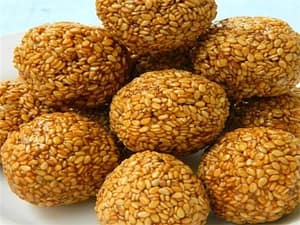Tilkut
Tilkut, alternatively recognized as tilkutam, gajak, or tilpatti, represents a confection originating from the regions of Bihar and Jharkhand in India.

Foods made from Til (sesame seeds) provide heat and energy to the body, both of which are needed to beat the cold in January. Ladoo made by mixing sesame and jaggery together, is definitely prepared on Makar Sankranti. Sesame jaggery ladoo is also called tilkoot. Making these laddus is very easy.
The History of Makar Sankranti
The history of Makar Sankranti dates back to ancient times in India. Annually observed on a consistent date, it coincides with either January 14th or 15th, aligning with the Hindu calendar.Makar Sankranti marks the sun’s transition into Makar Rashi .
The Benefits of Eating Tilkut
Tilkut, an integral confection in Indian culture for generations, is crafted from sesame seeds (til ka tilkut) and jaggery, imparting it with a unique blend of flavor and texture. Eating tilkut offers numerous health benefits, such as providing essential minerals like iron, magnesium, and copper. The inclusion of natural components not only enhances vitality but also contributes to increased energy levels, thanks to their carbohydrate content. Carbohydrates play a crucial role in converting food into energy, facilitating the process of digestion.
1. The high fiber content of tilkut can help to improve digestion and regular bowel movements. Its elevated soluble fiber content not only aids in lowering cholesterol levels but also serves as a preventive measure against constipation.
2. Tilkut is a very nutritious food that provides many health benefits. Abundant in protein, fiber, and vital nutrients like iron, magnesium, potassium, zinc, selenium, and B vitamins, it offers a wholesome nutritional profile.
3. Tilkut is rich in antioxidants, which can help protect the body from damage caused by free radicals that can lead to chronic diseases like cancer and heart disease.
4. Tilkut is also a good energy source due to its high-calorie content. Consuming tilkut on a regular basis provides the energy required for physical activities and everyday tasks.
5. Eating tilkut can improve heart health as it contains healthy fats and omega-3 fatty acids,which can help to lower cholesterol levels, reduce inflammation and keep blood vessels flexible.
6.Tilkut serves as a beneficial reservoir of magnesium, contributing to the maintenance of robust and healthy bones while also aiding in the regulation of blood pressure levels.
The History of Tilkut
The best Tilkoot is said to be from Gaya and is native only to the Magadha region. This dry sweet is mentioned in Buddhist literature as Palala.
According to Mahendranath Dutt’s ‘Old Tales and Customs of Calcutta’, Tilkut was born in Konnagar around 1873 to 1874. Tilkoot was once quite famous in this city. The history of Tilkoot has been researched by Subhdeep Kanswanik, a resident of Konnagar.
Type of Tilkut
Generally, three types of Tilkut are available – refined sugar tilkoot is white in colour, sugar tilkoot is made of unrefined sugar and is light brown in color and jaggery tilkoot is made of molasses and is dark brown in colour. Each of these varieties has its own flavor.
Round shaped delicacies are called tilkut and small nut-shaped ones are called Tiluri.
Ingredients for Tilkut
1. Sesame (sesame) – 500 g/4 cups
2. Jaggery – 500 grams
3. Ghee – 2 tsp
For the taste:
4.1/2 cups almond flour, optional
5. 1 tsp. cardamom powder
How To Make Tilkut
Clean the sesame seeds well.
Heat oil in a heavy pan (kadai) on medium heat, stir fry the sesame seeds until they turn light brown (if you grind them by hand you should grind them). Remember not to burn the sesame seeds as they give an instant bitter taste. Take out the roasted sesame seeds and grind them lightly or keep them in a mixer to a coarse powder.
Sesame powder roasted in melted jaggery, almond powder, cardamom powder Blend well. Sesame jaggery mixture is ready for making laddus. Apply ghee with your hands and smooth the mixture. Take a small amount (about 1 tablespoon) of the mixture at a time (the mixture needs to be warm to make the laddus, as the mixture hardens when it cools, making it difficult to make the laddus). Make round shaped laddus and keep them on a plate, similarly make laddus of the rest of the mixture and keep them on a plate.
Sesame jaggery ladoo is ready to eat. Keep the ladoos ready in open air for 4-5 hours You can take tilkoot from the pot whenever you want something sweet.
Tip: You can also keep 1/2 cup sesame seeds aside, make round laddus of the mixture and wrap them in sesame seeds. Shape them with your hands and place on a plate. White, luscious ladoos are ready.